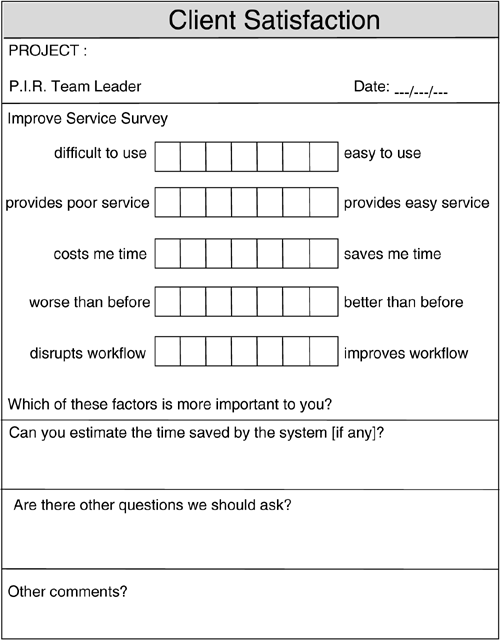The Learning Loop Concept 2
The Learning Loop Concept [2]
One of the most interesting behaviors that we have observed in organizations is the apparent inability of organizations to learn from their mistakes. This is particularly true in the case of projects. Probably through a combination of poor postimplementation review practice and the "victim" mentality , very few organizations have a formal mechanism for sharing lessons ”both good and bad ”among projects and project managers. The use of groupware technology can be very powerful in enabling project managers to share and access learning. The postimplementation review forms shown in Figures 18.5 and 18.6 should provide a good building block for establishing a postimplementation review knowledge base and a learning loop among projects. Figure 18.6. Client survey (improve service) form The postimplementation review is a valuable process for learning about how to manage projects better and for formalizing the learning process so that other project managers, stakeholders, sponsors, and members of steering committees can benefit for future projects. Typically, the postimplementation review will be too early in the support cycle to determine whether any financial benefits have been accrued. The postimplementation review will initiate the benefits realization plan that is discussed later in this chapter and will generally involve initial client satisfaction surveys. Client Satisfaction SurveysAs outlined in Chapter 9, many projects will have improve service categories of benefits and these need to be measured, as well as the financial and tangible benefits of increased revenue and avoided costs.
Figure 18.6 shows a typical client satisfaction form that can be used for determining whether the system has improved service to the various clients . Wherever possible, specific stakeholder meetings in which the system service impact can be openly discussed should be conducted with the forms as a supplement. Of course, if you had been applying the various eXtreme project management models and tools that we have covered in this wonderful book, then you should have already been gathering anecdotal evidence from your stakeholders about how well the project has been going and how wonderful this book is. (This paragraph has been deliberately inserted to see if you read it ”hopefully you will have found the book wonderful. You can always contact us at our Web site.) The Postimplementation Review TeamThe postimplementation review team is the group that undertakes the process and should include the following people at a minimum:
Again, this differs from the traditional approach in which postimplementation reviews were often conducted by purely external (to the team, that is) people. The noninvolvement of you, the project manager, and your team reduces the opportunities for learning and reflects a nontrusting attitude toward the team. Any chance of the postimplementation review being distorted by the project manager will be offset by the involvement of key stakeholders and external people. The postimplementation review report is sent to the project sponsor and members of the steering committee and copies should be forwarded to all stakeholders and related project managers. The learning loop information should be shared with as many people as possible. |
EAN: 2147483647
Pages: 136
